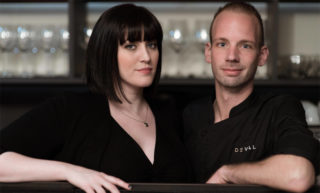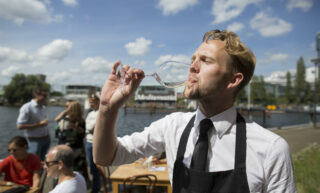Dutch-South African restaurant makes a strong case for Cape Cuisine
Margot Janse is back. After a six-year break since stepping down from her position as the Executive Chef at Le Quartier Français in Franschhoek, South Africa, the restaurant that featured for eight years on the list of the World’s 50 Best Restaurants, she has now embarked on a new culinary adventure with top sommelier Koen van der Plas. In November 2022 the two opened a new restaurant, SAAM, picturesquely located on Amstel River just outside Amsterdam, showcasing the diversity of South African ingredients and wine in an informal but genuinely hospitable setting, and with a keen eye for the well-being of all parties involved.
“Verbinding, or connectedness, is key to understanding restaurant SAAM,” Van der Plas says. The name, an acronym for South Africa on Amstel, and more importantly the Afrikaans word for together, is not just a catchy, noncommittal logo on the glass gabled façade of a strikingly renovated building – it sums up a host of ideas and activities that lie at the heart of a restaurant that wants to be more than a place where they serve food and wine. Janse and Van der Plas care about people.
Giving back to society
In 2009, years before quitting her job with Le Quartier Français, Janse, a Dutch citizen living in South Africa for more than thirty years, moved into charity. Through the Isabelo Foundation, of which she is the director, 1500 healthy meals are served to so-called “hungry minds” in Franschhoek. “Giving back to society is something you can do every day,” Janse says.
Van der Plas has a similar attitude. After he ended his sommelier career at, among others, the three-Michelin-starred restaurant Inter Scaldes, where he was the Head Sommelier, he started his own wine brand, NoHouseWine. It not only offers good quality for a reasonable price, but from every bottle sold he donates a brick to a charity that builds houses for the homeless in South Africa. Seventy houses have been built so far. The wines are currently available through a Dutch chain of organic supermarkets, but they will also feature as SAAM’s house wine when a new line of five wines, including a Syrah, a Chenin Blanc and a rosé, will be released later this year.
SAAM aims to be a fine-dining restaurant that supports the improvement of people’s well-being through an elevated gastronomic experience. “We want to incorporate the concept of ‘giving back to society’ in the fabric of the restaurant, instead of building up wealth that may (or may not) be given back after retirement,” Van der Plas explains. In that vein, most of the furniture and lamps in the restaurant are made by local South-African craftspeople and, together with the Spier Arts Trust in Cape Town, the restaurant space is slowly being transformed into a gallery for South-African artists.
Although South African wines take center stage – the wine list features a good mix of well-known producers and new finds – SAAM focuses otherwise on artisanal, family-owned, mostly organic European wine producers to support small businesses and minimize carbon emissions. Van der Plas consolidates his wine orders as much as possible to avoid small, inefficient deliveries.
As employers Janse and Van der Plas are acutely aware of the impact of their decisions on their personnel’s personal lives. After a hectic start, Van der Plas says, he now focuses on creating a comfortable, manageable workload for his employees. Old-fashioned, heavy-handed hierarchical work relationships are shunned: cooperation is key. Janse may be the face of the restaurant’s cuisine, but she prefers to inspire rather than make top-down decisions as a boss. The kitchen is run by a highly experienced team headed by Jasper Hermans. Janse visits for about two weeks every three months.
One of Janse’s main tasks, apart from supplying a large gamut of South-African ingredients, is providing the South African historical, cultural and culinary background for the team. Over the centuries the country and its cuisine have absorbed many different influences – Dutch, English, Portuguese, German, Malay – that interacted with the culture and history of the original population. Understanding these influences, including slavery and indentured labor, are essential for Janse and Van der Plas. The two are now also preparing to work with South African schools to set up an internship program. It not only creates opportunities for South Africans who would otherwise hardly be able to travel abroad, but it also helps to keep up the South African spirit of the restaurant.
With all these initiatives, SAAM reinforces a nascent Dutch food culture in which top quality cooking and hospitality is merged with responsibility, accountability and sustainability.
Jasper Hermans and Margot Janse ©SAAM
A unique palette of flavors
The melting pot nature of South Africa shines through in almost all dishes. The piquant sosati (Afrikaans for satay) of mushrooms, for example, and the rosehip-sambal-lacquered strawberries reference the Malay community, while the peri-peri tomatoes (a side of the melt-in-the-mouth lamb dish) reminds the diner of the Portuguese.
Even more impressive is the wealth of new flavors and aromas from all sorts of local herbs and nuts. The Cape is one the world’s botanically most diverse regions, and it shows on the p(a)late. The paste of marula nut (the kernel of an African fruit) provides the cod with some refreshing lift, hacha nuts (the kernels of the hacha or Mobola plum) give texture to the peri-peri tomatoes, zumbani (or lemon bush) add a citric verbena-like element to the fynbos herbs on the lamb, and the oil from the buchu leaves give the cream in the strawberry dessert a tropical touch. As a result, the palette of flavors is broad, unique and surprising but without estranging you from a European fine-dining experience.
Based on South African customs, the service is loose and informal, but, as both Van der Plas and Janse emphasize, with a deeply felt sense of hospitality. Nonetheless, don’t consider SAAM a South African restaurant – it is Dutch-European with (strong) South African influences. There is no braai, but the word is used frequently by the waiting staff when serving dishes that are grilled, like, for instance, the succulent red mullet grilled on the skin with mussels, saffron and a vinaigrette of the mussel juice, and the (grilled) celeriac with seaweeds and tart, floral suurvygie (sour fig).
The sizeable South African community in The Netherlands, Janse and Van der Plas say, recognize their home country, both in flavor and atmosphere, without the restaurant being a copy from Cape Town or Jo’burg. Ingredients like fynbos herbs, marula, and honeybush (a more fragrant and fresher sibling of rooibos) add instantly familiar aromas to a dish, but they aren’t always used in a traditional way. Interestingly enough, the South African clientele, according to Janse, often don’t know their own ingredients by name, but they do recognize them.
Wadden oyster and Seabuckthorn ©Bart de Vries
Dutch produce, South African flavour
To limit carbon emissions, produce is sourced in The Netherlands as much as possible.
In some dishes a typically South African flavor combination is thus created with Dutch ingredients, like the Wadden oyster with flavor-enhancing seabuckthorn granité, a wonderful, slightly more elaborate and complex variation on the classic oyster with a drop of lemon. Seabuckthorn is an often-used South African acidifier and flavoring, but it is also available in the Dutch dunes along the North Sea coast. Sometimes a dish gets a Dutch translation. The spekbokking (cold smoked herring), for instance, is a replacement for the dried and salted mullet, an ingredient used by Wolfgat, Janse’s favorite restaurant in South Africa.
Peri-peri tomatoes ©Bart de Vries
SAAM is barely a year old – it is a baby that has just started to crawl, as Janse vividly describes it. To which Van der Plas adds that a restaurant is like a wooden boat, once you have given it a lick of paint, you have to start all over again. In other words, it is a work in (continuous) progress. Nonetheless, the kitchen team churns out balanced, interesting, often complex and above all delicious dishes, as if the chefs are the cogs of a well-oiled machine that has been running for a long time. Likewise, the waiting staff feel like an attuned team that deliver smooth, friendly and approachable service. Connectedness and horizontal organization seem to bear fruit indeed. We left feeling satisfied, content and inspired. SAAM not only brings a new range of flavors to the European table, but its community focused approach also forms a refreshing counterpoint to the indulgent experience of fine dining.






Comments